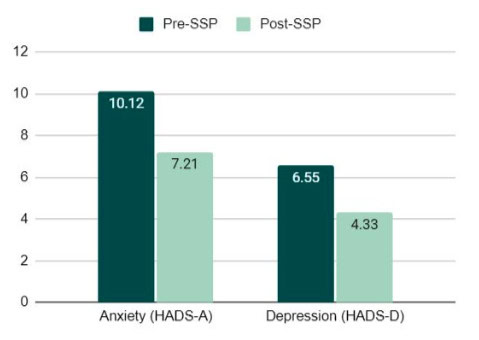| By Unyte Editorial Team Reviewed by Unyte Clinical Team |
Voice and throat disorders can significantly impair a person’s quality of life and manifest as symptoms such as voice handicaps, pharyngeal globus (the persistent sensation of a lump in the throat), and breathing problems. Treatment of these conditions can be challenging, especially when there is no clear diagnosis. When presented with these cases, what tools can providers consider?
Addressing nervous system dysregulation may be an effective approach rather than targeting individual symptoms. In a new article published in the peer-reviewed academic journal Music and Medicine, a group of researchers explores the connection between voice and throat symptoms and autonomic dysregulation, anxiety, and depression, and the potential of the Safe and Sound Protocol (SSP) as a part of treatment. This publication offers valuable insights into understanding these complex symptoms through a bottom-up, neurophysiological approach informed by Dr. Stephen Porges’s Polyvagal Theory.
A Polyvagal Look at Medically Unexplained Voice and Throat Symptoms
The researchers conducted two studies. First, they examined the connection between voice and throat problems and autonomic dysregulation. Through clinical assessments, they found that people with these symptoms reacted more strongly to stress in parts of the body influenced by the vagus nerve above the diaphragm. This finding supports the idea that the normal functioning of the voice and throat is disrupted when the body’s stress response is too active (high arousal).
“Prior to this study, I shared with Dr. Porges my experiences in my work as an SLP, [and] voice and trauma therapist. I saw that many clients who, despite the fact that the ENT physician did not detect any abnormalities, experienced a strong complaint experience,” said Heleen Grooten-Bresser, a speech therapist specializing in voice therapy for 40 years and the article’s lead author. “[Polyvagal Theory] gave me the insight that many of my clients were possibly trauma survivors, in conjunction with which they had developed a dysregulated autonomic nervous system resulting in voice, throat and breathing complaints.”
Additionally, the study found a positive correlation between voice handicaps and anxiety and depression. This suggests that not only do these symptoms affect a person physically, but they also cause an emotional impact. While more research is recommended, this helps us understand how managing stress and the body’s reaction to it could be key in helping people find support for these symptoms.
Examining the Impact of the Safe and Sound Protocol (SSP)
The SSP, created by Dr. Stephen Porges, is a practical application of Polyvagal Theory. Using music that has been specially filtered through the patented, evidence-based algorithm, the SSP highlights specific frequencies within music that send cues of safety to the body. It is designed to regulate the autonomic nervous system, helping the listener think, feel and connect better with others.
Participants demonstrated a significant decrease in anxiety, depression and autonomic reactivity post-SSP.

In the second study, the researchers explored the effectiveness of the SSP when delivered to 33 individuals aged 29 to 74 with self-reported voice, throat, and/or respiratory complaints, focusing on its impact on autonomic reactivity, anxiety, and depression, measured by standardized clinical assessments.
Breakdown of Symptoms
| Symptom(s) | Percentage of Clients Affected (%) |
|---|---|
| Voice complaints | 21.2 |
| Pharyngeal globus | 9.1 |
| Breathing problems | 15.2 |
| Combination of voice, breathing and globus complaints | 18.2 |
| Combination of voice, breathing and tinnitus complaints | 15.2 |
| Stuttering, nonfluent speech | 9.1 |
| Jaw, jaw clinching problems | 9.1 |
| Tinnitus | 3 |
The participants underwent the SSP for several days, delivered by a voice therapist, typically listening to 60 minutes for five consecutive days. (Clinician’s note: Delivery of the SSP may be titrated to as low as a few minutes per session to meet each client’s nervous system.) Assessments were conducted before and within one week after the treatment, and showed significant change: participants reported reductions in anxiety, depression, and autonomic reactivity, and specifically saw improvements in functions controlled by the vagus nerve above the diaphragm.
“This research, conducted at the request of Dr. Porges, confirmed my suspicion that emotional dysregulation also plays a role in the background of voice, throat, and breathing complaints: many of the clients with these complaints have high anxiety-depression scores, among other things,” said Grooten-Bresser. “After regulation of the autonomic nervous system by means of SSP, voice, throat, and breathing complaints are reduced, and anxiety and depression scores also appear to decrease significantly.”

Case Study: Safe and Sound Protocol (SSP) helps client with spasmodic dysphonia find his voice
Jack, 69, presents with spasmodic dysphonia, a neurological disorder affecting the voice, with stress on his vocal cords. See how the SSP was able to help him “gain his life back.”
These results demonstrate the SSP’s potential to shift the autonomic nervous system out of a sympathetic “fight-or-flight” state. When the nervous system is able to access the social engagement system within a parasympathetic state, the body is more able to function normally, which also allows the client to feel calmer and be more receptive to other interventions, such as speech therapy.
Integrating the SSP into Speech Therapy
This study highlights the need for a broader approach that considers the role of the autonomic nervous system and physiological well-being, rather than aiming only to alleviate physical symptoms.
“Proper Polyvagal-informed training and training in the application of SSP will, I hope, be able to help many more people effectively in the future,” added Grooten-Bresser.
The SSP is an adjunct therapy that complements existing treatment strategies, and may offer relief to providers and clients seeking to build on therapies they are currently undergoing to address voice and throat disorders.
References
Grooten-Bresser, H., Heilman, K. J., Kooijman, P. G. C., Monti, E., Chenault, M. N., Holmes, L. G., & Resto, O. (2024). Speech therapy clients with voice, throat and respiratory complaints: Self-reported autonomic reactivity, anxiety and depression and effects of Safe and Sound Protocol. Music and Medicine, 16 (2) https://doi.org/10.47513/mmd.v16i2.944




 © 2025 Unyte Health US Inc.
© 2025 Unyte Health US Inc.